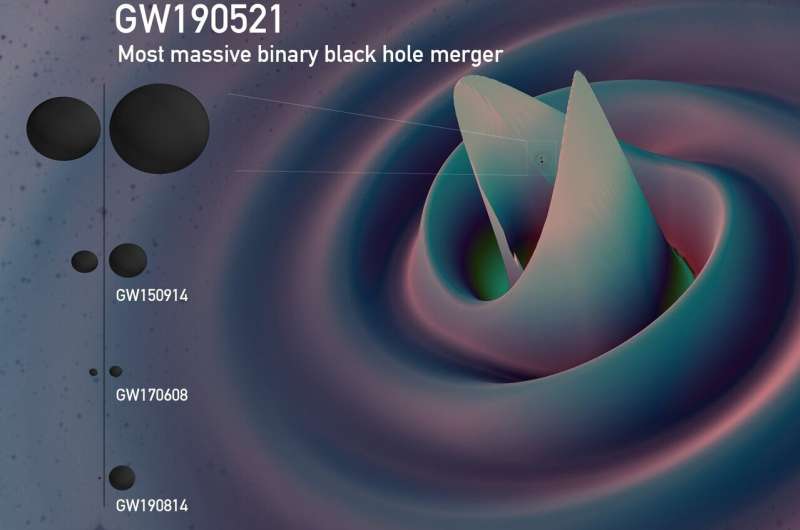The most massive binary black hole merger. This graphic shows a still from a numerical relativity simulation consistent with GW190521. The ripples illustrate the spacetime curvature and gravitational waves produced by the pair of merging black holes. The bottom shows the gravitational wave signal as a function of time. The left shows representations of the black hole event horizons for GW190521 and other massive black hole binaries detected by LIGO/Virgo. (Credit: D. Ferguson, K. Jani, D. Shoemaker, P. Laguna, Georgia Tech, MAYA Collaboration).
In September 2020, the LIGO/Virgo collaboration, a large team of scientists working at different universities worldwide, announced that they had detected most massive gravitational wave binary signal observed to date, which they called GW190521. In a paper published in Physical Review Letters, they explored the hypothesis that this signal was produced by the merger of two black holes, with at least the primary component mass in the mass gap predicted by the pair-instability supernova theory.
Researchers at Université de Genève, Technion, Sapienza University and INFN have recently examined the LIGO/Virgo data further and explored an alternative explanation for the GW190521 event. In their paper, also published in Physical Review Letters, they specifically considered the possibility that the GW190521 event could be associated with primordial black holes, those produced in the early universe.
"Our paper originated from the observation by the LIGO/Virgo collaboration of the so-called GW190521 event, the merger of two black holes," Antonio Riotto, one of the researchers who carried out the study, told Phys.org. "The more massive black hole turns out to be in the so-called mass gap, that is, in a range of masses where astrophysical arguments are deficient in explaining the astrophysical nature of such a black hole. Our primary objective was to understand if the event could have an explanation within the primordial black hole scenario, i.e., by those black holes that are generated in the early universe and whose masses may fall in the mass gap without any problem."
To examine the possibility that a signal is associated with the so-called primordial black hole scenario, one can compute the rate at which two black holes of primordial origin merge (i.e., their merger rate) to produce a gravitational wave signal. Subsequently, researchers must compare this prediction to the merger rate that would be needed to explain the signal observed.
"Matching such a prediction to the observed rate needed to explain the GW190521 event, we found the parameters of the scenario [that were] needed and checked whether they escaped the current constraints from other experiments, e.g., those from cosmic microwave background (CMB) constraints," Riotto said. "Indeed, it turns out that the GW190521event may be explained by our initial primordial black hole hypothesis."
Riotto and his colleagues demonstrated that the GW190521 event observed by the LIGO/Virgo collaboration could be theoretically explained by the merger of primordial black holes. In the future, their work could thus inform other studies aimed at confirming the existence of primordial black holes. Meanwhile, the researchers plan to explore the possibility that other events detected by LIGO/Virgo collaboration originated from primordial black holes.
"As part of the ongoing effort to establish the existence of primordial black holes using current and future gravitational wave data, we have organised a workshop bringing together scientists studying black holes from both the primordial and the astrophysical communities, as well as members of the LIGO/Virgo collaboration, with the aim of creating synergies between experts of different fields," Gabriele Franciolini, another researcher involved in the study, told Phys.org. "With more than 300 participants, the large participation proves the widespread interest of the scientific community in this exciting line of research."
More information: GW190521 mass gap event and the primordial black hole scenario. Physical Review Letters(2021). DOI: 10.1103/PhysRevLett.126.051101
GW190521: A binary black hole merger with a total mass of 150 M⊙. Physical Review Letters(2021). DOI: 10.1103/PhysRevLett.125.101102
Journal information: Physical Review Letters
© 2021 Science X Network
























